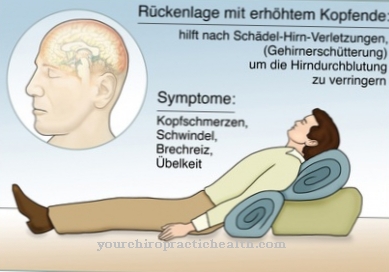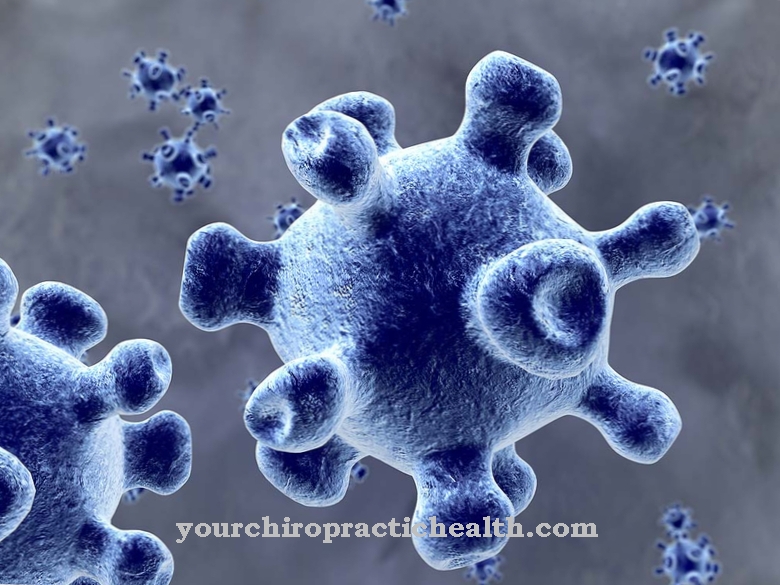Under the Meralgia paraesthetica a nerve compression syndrome is understood. It also bears the name Inguinal tunnel syndrome.
What is meralgia paraesthetica?

© Sebastian Kaulitzki - stock.adobe.com
From one Meralgia paraesthetica is the term used in medicine when the lateral femoral cutaneous nerve is trapped. This nerve has its origin in the lumbar plexus. It is also equipped with generally somatosensitive fibers.
The thin nerve is located below the inguinal ligament and is responsible for supplying the thigh region up to the knee. In the case of meralgia paraesthetica, those affected suffer from pain that is almost electrifying. In addition, half of all patients experience numbness.
The Meralgia paraesthetica is also known as Inguinal tunnel syndrome or Bernhardt-Roth syndrome. Meralgia paraesthetica is one of the most common bottleneck syndromes. It appears three times as often in the male sex as in the female. In principle, meralgia paraesthetica can break out in anyone.
causes
Meralgia paraesthetica is usually caused by mechanical pressure below the inguinal ligament. However, tensile or pressure effects in the course of the lateral femoral cutaneous nerve can also be responsible for the development of the syndrome, which is particularly true for the pelvic outlet region. In some cases, nerve damage during medical treatment is also the reason for painful meralgia paraesthetica.
This can be a puncture of the iliac crest, an opening in the abdominal wall or the removal of bone chips. The occurrence of meralgia paraesthetica is often favored by special risk factors. This is primarily high pressure on the inguinal ligament due to pregnancy, being overweight (obesity) or too tight belts or pants.
An additional risk factor is diabetes mellitus. Standing work activities that involve a strong extension of the hips, long marches and extensive strength training on the hips, thighs or stomach are also considered unfavorable. The pain in meralgia paraesthetica is caused by compression of the lateral femoral cutaneous nerve, as certain muscle fibers penetrate. For this reason, the nerve kinks by around 90 degrees.
Symptoms, ailments & signs
Meralgia paraesthetica is noticeable by burning pain that occurs on the outer side of the thigh. In addition, those affected suffer from unpleasant paresthesias such as numbness, impaired perception or tingling. If the affected person bends their hip joint in the anterior direction, the symptoms improve.
In the further course of the inguinal tunnel syndrome, sensitivity disorders such as hypalgesia or hypesthesia also appear. About 20 percent of all patients suffer from the symptoms on both sides of the body. Sometimes meralgia paraesthetica proves to be so uncomfortable that even wearing clothes causes discomfort in those affected. There is no loss of strength due to the inguinal tunnel syndrome because the lateral cutaneous nerve does not contain any motor fibers.
Diagnosis & course of disease
If you suspect meralgia paraesthetica, a visit to a doctor is recommended. He begins his examination by recording the medical history (anamnesis) of his patient. He then does a thorough physical exam. This also includes a neurological assessment, which usually reveals noticeable sensitivity disorders on the outside of the thigh.
In addition, the patient usually reacts sensitively to pressure pain that the doctor creates by applying pressure with two fingers on the anterior superior iliac spine. At this point, the nerve passes through the inguinal ligament. In some patients, the doctor can also derive pathological somatosensitive evoked potentials (SEP).
In some cases, a magnetic resonance imaging (MRI) scan is appropriate, which is used to better assess the inguinal ligament structures. Meralgia paraesthetica takes a positive course in most patients. The pain improves in nine out of ten people affected. However, every fourth patient suffers from spontaneous remission.
Complications
Meralgia paraesthetica gives the patient very unpleasant feelings of paralysis or numbness. In most cases, those affected suffer from a strong tingling sensation or from perception and sensory disorders. In some cases pain can also occur, which can spread to other regions of the body. The quality of life is significantly reduced and restricted by the sensitivity disorders.
Various paralyzes can also lead to restrictions in everyday life, so that those affected are dependent on the help of other people through the meralgia paraesthetica. Pain occurs mainly in the form of pressure pain or stress pain. If there is rest pain, it can also lead to sleep problems during sleep.
Meralgia paraesthetica is treated with the help of pain relievers and various therapies. In most cases there are no complications and the symptoms can be alleviated relatively well. As a rule, however, it cannot be predicted whether a complete healing will occur. Life expectancy is usually not affected by the disease.
When should you go to the doctor?
Disorders of perception or sensitivity disorders on the skin must be clarified by a doctor. A tingling sensation or numbness are causes for concern. The symptoms often increase in scope and persist for several days or weeks. If there is pain on the outer side of the thigh, a doctor is needed.If locomotion is impaired as a result of the symptoms or if gait is unsteady, the general risk of accidents and injuries increases. A visit to the doctor is necessary so that a treatment plan can be drawn up and the possible risks can be minimized.
A loss of strength, impairment in fulfilling everyday obligations or a decrease in physical activity should be discussed with a doctor. If you have restricted mobility or you are unable to carry out your usual professional activities, you should consult a doctor. If the body has incorrect posture due to the complaints in the thigh, a visit to a doctor is recommended.
If the posture is permanently incorrect, damage to the skeletal system can develop, which should be prevented. If, in addition to the physical discomfort, there are also mental abnormalities, a doctor is required. If you are irritable, have mood swings or withdraw from social life, it is advisable to consult a doctor. If the locomotion is severely reduced, countermeasures should be worked out and taken.
Treatment & Therapy
The therapy of a meralgia paraesthetica depends on the triggering cause. It is also advisable to tailor the treatment to the individual needs of the patient. The longer the complaints last, the more the chances of recovery deteriorate. The patient can also help to improve his or her symptoms by avoiding wearing tight clothing or exercising extension postures with the hip joint.
In the case of conservative treatment, pain relievers such as nonsteroidal anti-inflammatory drugs (NSAIDs) are usually used. Preparations such as baclofen, gabapentin, pregabalin, carbamazepine and pyrimidine nucleosides can also be administered. Supplementary analgesics such as ibuprofen are also considered useful for therapy. Treating existing underlying diseases is also extremely important.
If none of these therapeutic measures bring about any improvement in the symptoms, an operation can be considered. Either decompression of the affected nerve or even cutting it takes place. Severing the nerve causes complete numbness within the supply area.
On the other hand, there is the possibility that the nerve end that is formed reacts very sensitively to tissue pressure, which in turn results in new pain. Therefore, cutting the lateral femoral cutaneous nerve is not recommended. On the other hand, during a surgical procedure the leaf parts on the inguinal ligament are severed in such a way that movements of the hip joint can no longer cause pain in the small nerve.
You can find your medication here
➔ Medicines for painOutlook & forecast
The prognosis for Meralgia paraesthetica is generally favorable. Conservative treatment will be initiated as soon as the diagnosis is made. In addition, the person affected can contribute significantly to positive development by changing their posture and movement sequences to alleviate their own complaints.
Without medical care, the symptoms can be expected to remain constant. In addition, the physical impairments can cause pain or other secondary diseases. In particular, the muscular system is additionally stressed, so that poor posture and tension are to be expected in the event of an unfavorable course. Unsteady gait occurs and general locomotion is difficult.
If the person concerned see a doctor, medication is prescribed as a first step. In addition, physiotherapy training can be arranged. In these, the person concerned learns how to optimize his movement sequences in the long term. If the drug treatment remains unsuccessful, an operation is carried out. Although the operation is risky, it is often the last resort to improve the overall situation. At the same time, exercises should still be carried out to improve movement. If the surgical procedure and wound healing go smoothly, the person affected will be released from treatment within a few weeks as having recovered.
prevention
No specific preventive measures against meralgia paraesthetica are known. However, it is important to avoid certain risk factors such as being overweight or wearing too tight clothing.
Aftercare
Since meralgia paraesthetica cannot heal itself, follow-up care focuses on alleviating the symptoms and improving quality of life. Various complications and complaints can occur with meralgia paraesthetica. In most cases, this disease causes various feelings of numbness or impaired perception. Those affected often suffer from a tingling sensation in various parts of the body, and these complaints also make everyday life much more difficult. The sensation of temperature is also reduced and made more difficult by the meralgia paraesthetica. In children, the disease can lead to significant developmental disorders if not properly treated.
These symptoms can even occur when wearing clothes and have a negative impact on the everyday life of the person concerned. Many patients therefore not infrequently develop mental moods or even depression, which should be clarified by a psychologist. Therapy is sometimes advisable. Contact with other equally ill people can also help to alleviate suffering and promote the exchange of experiences.
You can do that yourself
Patients with meralgia paraesthetica experience unpleasant symptoms such as pain, tingling and numbness in the thigh. The disturbances in sensitivity and pain perception have a negative effect on the quality of life. The patients see a doctor and take full advantage of all the check-ups, which often take place at various medical specialists. After the diagnosis, the treating physicians set a treatment plan that the patient strictly adheres to in his own interest.
So the person concerned takes the prescribed painkillers at the specified time. If there are side effects from the drugs, the patient reports this immediately to the responsible doctor or an emergency doctor. Many patients report the unpleasant effects of too tight clothing on the sensory disorders. It is therefore helpful to find individually suitable clothing that does not worsen the symptoms.
Physiotherapy has a beneficial effect on the state of health and thus the quality of life of those affected. However, this is usually only an accompanying therapy, as the pain does not go away. If desired, those affected can undergo an operation, in which the surgeons often cut the nerve. Post-operatively, patients stay in the clinic and follow the doctors' rules of conduct.


.jpg)









.jpg)



.jpg)










.jpg)
